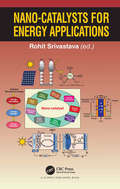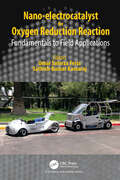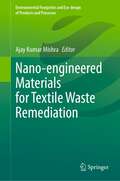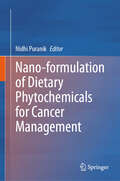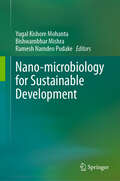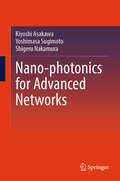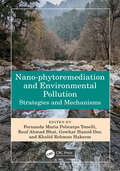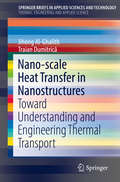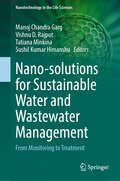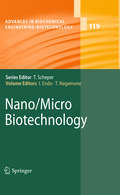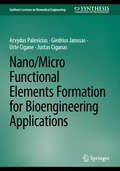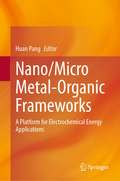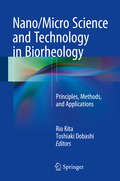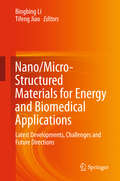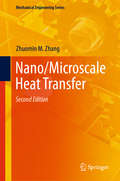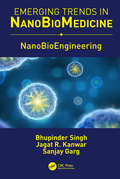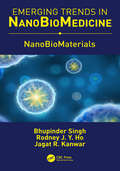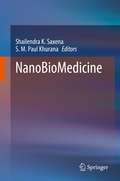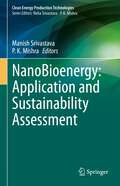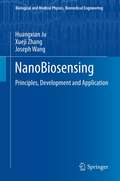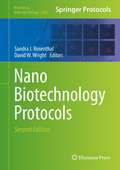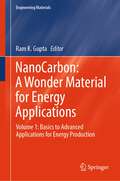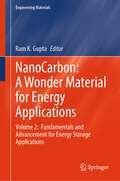- Table View
- List View
Nano-biotechnology for Waste Water Treatment: Theory and Practices (Water Science and Technology Library #111)
by Jai Prakash Narain Rai Shweta SaraswatThis book embodies the potentials of nanobiotechnology-based water treatment techniques to provide a solid understanding of the subjects. Starting with a refresher of the basic conventional technologies which are now been integrated with nanomaterials for an efficient, viable, and eco-friendly treatment of contaminated water. The book covers various physical, chemical, and hybrid methods of nanobiomaterial synthesis and their fabrication for characterizing existing techniques. The book gives special attention to those nanotechnology-based approaches that promise easier, faster, and cheaper processes in contaminants monitoring and their treatment. Several case studies explain in an easy to understand format how employing nanobiomaterials as an indicator and analytical tool will enable students to learn about cleaning up the environment.
Nano-catalyst for Energy Applications
by Rohit SrivastavaThis book comprises of chapters based on design of various advanced nano-catalysts and offers a development of novel solutions for a better sustainable energy future. The book includes all aspects of physical chemistry, chemical engineering and material science. The advances in nanoscience and nanotechnology help to find cost-effective and environmentally sound methods of converting naturally inspired resources into fuels, chemicals and energy. The book leads the scientific community to the most significant development in the focus research area. It provides a broad and in-depth coverage of design and development advanced nano-catalyst for various energy applications.
Nano-electrocatalyst for Oxygen Reduction Reaction: Fundamentals to Field Applications
by Sathish-Kumar Kamaraj Omar Solorza FeriaGlobal warming switches our reliance from fossil fuels to green, sustainable renewable energy sources. Because of its promising nature, high-efficiency nano-electrocatalysts have sparked interest in renewable energy. Hydrogen fuel cell/polymer electrolyte membrane (PEM) vehicles are the most environmentally conscious electromobility vehicles, with a high energy density and quick refuelling technology, prompting the auto industry to launch a variety of PEM fuel cell vehicles around the world. Oxygen reduction reaction (ORR) primary research interests include fuel cells and metal-air batteries. The sluggish kinetic reaction of ORR, which is responsible for the rate-limiting reaction at the PEM fuel cell cathodic system, further decreases energy efficiency. Optimising ORR for market expansion with cost-effective and efficient nano-electrocatalysts, on the other hand, remains a challenge.The book covers fundamental ORR reaction kinetics theories, tools, and techniques. It also explains the nano electrocatalysts for ORR made of noble, non-noble, and nanocarbon materials. Finally, the book explores the applications of PEM fuel cells and metal-air batteries.
Nano-engineered Materials for Textile Waste Remediation (Environmental Footprints and Eco-design of Products and Processes)
by Ajay Kumar MishraThis book presents a complete state of the art for different types of nanomaterial, their environmental fate, and their use in textile waste remediation. Nano-engineered materials including nanoparticles, nanofibers, nanotubes have been used extensively for a variety of applications. Environmental concerns have been noted mainly due to the discharge of textile waste. Nanotechnology is fast growing on research and bringing sustainable solution in minimizing the waste. This also minimizes the risk of exposure and health hazards. With the development of industry, environmental pollution and energy shortage have raised awareness of a potential global crisis. So, it is urgent to develop a simple and effective method to address these current issues. Nano-engineered materials can be better solution in finding solution of environmental sustainability more specific to the textile waste remediation. Nano-engineered materials have emerged as pioneering photocatalysts and account for most of the current research in this area. This can provide large surface areas, diverse morphologies, abundant surface states, and easy device modeling, all of which are properties beneficial to photodegradation. Furthermore, the stability and cost of nano-engineered materials are critical factors. Therefore, it is a challenge of great importance to identify and design nano-engineered materials that are efficient, stable, and abundant for the remediation of textile waste.
Nano-formulation of Dietary Phytochemicals for Cancer Management
by Nidhi PuranikThis book covers various cancer chemotherapeutics, offering research-oriented overviews of phytochemical-based cancer treatments. It contrasts nano-formulated phytochemical delivery with conventional chemotherapy, introducing nanocarriers or bioengineering for poly-chemotherapy and phytochemicals as alternative treatments to reduce resistance. The text elaborates on the nano-formulation techniques and synthesis approaches of phytochemicals as drugs, the targeted drug delivery facilitated by nanocarriers, and subsequent mechanisms of drug release. Additionally, it examines the implications of nano-formulated phytochemicals in cancer therapeutics and their impact on cancer treatment and prevention. By enhancing bioavailability and improving functional qualities through nanoencapsulation, this innovative approach promises significant advancements in cancer therapy. Key concepts include dietary phytochemicals' role in various types of cancer chemotherapeutics, the pharmacological mechanisms of action in prevention and treatment, and strategies to enhance chemotherapy and radiotherapy efficacy. The book also presents preclinical and clinical studies on the efficacy of phytochemicals in cancer treatment. Additionally, it highlights improvements in drug delivery systems using nanotechnology-based dosage forms for herbal drugs. The content is designed for professionals involved in drug development, including chemists, pharmacists, biologists, biotechnologists, industrialists, nanotechnologists, microbiologists, economists, and all disciplines related to cancer treatment and phytochemical-based drug development. Academic students, scientists, and researchers at universities, institutes, hospitals, botanical institutes, pharmaceutical industries, government organizations, and NGOs will find invaluable insights into the application of phytochemical drugs in cancer treatment. By providing a detailed examination of cutting-edge research on nano-formulated phytochemicals for cancer therapy, this book invites readers to rethink traditional approaches to chemotherapy and explore innovative solutions that promise better outcomes for patients worldwide.
Nano-microbiology for Sustainable Development
by Ramesh Namdeo Pudake Yugal Kishore Mohanta Bishwambhar MishraMicrobial diversity and microbial technology are critical to achieving most of the UN Sustainable Development Goals (SDGs), mainly due to their central role in the provision and regulation of ecosystem services. Despite this intensification of effort, more than 90% of microbial diversity remains to be discovered. Thus, the most unique characteristic of microbial technology is the exceptional diversity of applications it can address and the range of human activities and needs to which it is and can be applied. Separately, nanotechnology and microbiology have produced innovative solutions for human well-being and ecological and environmental equilibrium. The development of interdisciplinary research practices combining nanotechnology and microbiology to deliver creative solutions for human health and environmental and ecological damage is urgently required. The nanotechnology of microorganisms is contributing to the development and innovation of numerous industries. This book will explain the fundamentals and methods of the biological production of nanoparticles from microorganisms, such as bacteria, fungi, and algae. It will describe optimization strategies for microbe-mediated nanoparticle production. The book will also discuss the industrial and agricultural applications of nanoparticles produced by microbes. It also describes the applications of green nanoparticles in the health and pharmaceutical sectors, such as the treatment of multidrug-resistant infections and cancer. Overall, the book focuses on the broad subject areas of microbial nanotechnology and its possible applications in food, pharmaceuticals, water, environmental remediation, etc. However, the lack of information and the potential for negative effects on the environment, human health, safety, and sustainability remain obstacles. This book addresses these issues. Researchers and students in the agricultural sciences, materials sciences, biotechnology, microbiology, and pharmaceutical sectors will find this an invaluable resource.
Nano-photonics for Advanced Networks
by Kiyoshi Asakawa Yoshimasa Sugimoto Shigeru NakamuraThis book encourages optoelectronic researchers and engineers to exploit innovative nano-photonic applications in next-generation information and communications systems. The authors discuss applications enabled by three forms of nano-photonics: silicon photonics, photonic crystals and surface plasmons, with a view to the development of the defining applications and technologies of tomorrow. They explain topics clearly for readers both new to the field and experts in photonics, providing: basic knowledge of the general structures, physics and characteristics of optoelectronic devices; advanced understanding of the specific structures, physics and characteristics of the latest nano-scale optoelectronic and surface-plasmonic devices and related technologies; and an account of practical applications for each form of nano-photonics, among them: optical transception, LiDAR, optical neuro-computing, optical random access memory and high-power and narrow-beam surface-emitting lasers. The book is organised to treat the basics of each form of nano-photonic device and then the applications. Specialist researchers studying and practitioners employing nano-photonics will find Nano-photonics for Advanced Networks to be a useful means of keeping track of both the properties and applications of such devices. The book will also serve graduate students well as a comprehensive sourcebook for the subject.
Nano-phytoremediation and Environmental Pollution: Strategies and Mechanisms
by Khalid Rehman Hakeem Rouf Ahmad Bhat Gowhar Hamid Dar Fernanda Maria Policarpo TonelliThe book discusses nano-phytoremediation: the use of nanotechnology in combination with phytoremediation to restore polluted environs. The potentiality of plants in association with nanomaterials to effectively remediate polluted areas is elaborated meritoriously in this book. New strategies are necessary because anthropogenic actions represent a serious threat to life on Earth. This book has given enough space for a discussion of innovative and efficient technologies to restore damaged environs primarily focused on nano-phytoremediation. The first part of the book is dedicated to exploring organic and inorganic pollution and the threats they pose to living forms. The second part explores the joint use of plants and nanomaterials and the nano-phytoremediation of water and soil ecosystems. The book offers readers extensive knowledge on nano-phytoremediation as a feasible strategy to clean environmental pollution. The key features of the book are as follows: Nano-phytoremediation strategies to remediate soil and water ecosystems. Special chapters dedicated to different kinds of pollutants and methods of phytoremediation. Strategies to evaluate the success of nano-phytoremediation strategies, cost-effectiveness, and nano informatics to safe nanotechnology. The book can be used as a primary or supplementary text in undergraduate, graduate, and post-graduate courses such as biotechnology, biochemistry, and environmental engineering. It is an interesting edition for instructors, researchers, and scientists working on environmental management and pollution control.
Nano-scale Heat Transfer in Nanostructures: Toward Understanding And Engineering Thermal Transport (SpringerBriefs in Applied Sciences and Technology)
by Jihong Al-Ghalith Traian DumitricăThe book introduces modern atomistic techniques for predicting heat transfer in nanostructures, and discusses the applications of these techniques on three modern topics. The study of heat transport in screw-dislocated nanowires with low thermal conductivity in their bulk form represents the knowledge base needed for engineering thermal transport in advanced thermoelectric and electronic materials, and suggests a new route to lower thermal conductivity that could promote thermoelectricity. The study of high-temperature coating composite materials facilitates the understanding of the role played by composition and structural characterization, which is difficult to approach via experiments. And the understanding of the impact of deformations, such as bending and collapsing on thermal transport along carbon nanotubes, is important as carbon nanotubes, due to their exceptional thermal and mechanical properties, are excellent material candidates in a variety of applications, including thermal interface materials, thermal switches and composite materials.
Nano-solutions for Sustainable Water and Wastewater Management: From Monitoring to Treatment (Nanotechnology in the Life Sciences)
by Vishnu D. Rajput Tatiana Minkina Sushil Kumar Himanshu Manoj Chandra GargThe proposed book aims to provide a comprehensive overview of the advancements and potential applications of nanotechnology in addressing the challenges of water and wastewater management. The book intends to explore the latest research findings, innovative technologies, and emerging trends in utilizing nanomaterials for sustainable and efficient water treatment processes. The primary purpose of this new book is to bridge the gap between nanotechnology and water/wastewater management by presenting cutting-edge research and practical applications. The main objective of this new book is to serve as a valuable resource for researchers, engineers, policymakers, and professionals working in the field of water and wastewater treatment. The wide range of topics, including nanomaterial synthesis, characterization techniques, various nanotechnology-based treatment processes, nanomaterials for contaminant removal, nanosensors for water quality monitoring, and nanotechnology-enabled resource recovery will be covered in this book. As the authors of this book, our motivation stems from the urgent need to address global water scarcity and pollution issues. The nanotechnology holds immense potential in revolutionizing water and wastewater management practices by offering highly efficient, cost-effective, and sustainable solutions. By compiling and presenting the latest research and advancements in this field, we aim to inspire further research, collaboration, and innovation in utilizing nanotechnology for the betterment of water resources and environmental sustainability. The main goal of this new book is to contribute to the dissemination of knowledge and promote the adoption of nanotechnology in achieving sustainable water and wastewater management worldwide.
Nano/Micro Biotechnology
by Isao Endo Teruyuki NagamunePart I The Nano-Scale Biological Systems in Nature; Molecular bio-motors in living cells - by T. Nishizaka; The form designed by viral genome - by K. Onodera; Part II Detection and Characterization Technology; Atomic force microscopy applied to nano-mechanics of the cell - by A. Ikai; Design, synthesis and biological application of fluorescent sensor molecules for cellular imaging - by K. Kikuchi; Dynamic visualization of cellular signaling - by Q. Ni and J. Zhang; Part III Fabrication Technology; Surface acoustic wave atomizer and electrostatic deposition - by Y. Yamagata; Electrospray deposition of biomolecules by V.N. Morozov; Part IV Processing Technology; Droplet handling - by T.Torii; Integrated microfluidic systems - by S. Kaneda and T. Fujii; Part V Applications; A novel non-viral gene delivery system: Multifunctional envelope-type nano device - by H. Hatakeyama, H. Akita, K. Kogure, and H. Harashima; Biosensors - by M. Saito, H.M. Hiep, N. Nagatani, and E.Tamiya; Micro bioreactors - by Sato and T. Kitamori
Nano/Micro Functional Elements Formation for Bioengineering Applications (Synthesis Lectures on Biomedical Engineering)
by Giedrius Janusas Arvydas Palevicius Urte Cigane Justas CiganasIn recent years, various technologies dedicated to the formation of micro- and nanostructures have been intensively developed. Microstructures and nanostructures are manufactured from various materials with different parameters in a wide range of industrial sectors. These structures are used in devices such as biosensors, optical devices, microfluidic devices, electronic components, fluid mixing devices, particle separation or mixing devices, and single-molecule analysis devices. In this book technologies are being developed for the formation of nano/micro structures that allow the creation of new types of functional elements used in bioengineering. A magnetostrictive converter was developed and studied for the formation of microstructures in polymers, and a newly developed technology using mechanical vibrations during the chemical process was used to form aluminum nanopores. The synergy of these two technologies ensures the creation of a new type of functional elements used in bioengineering. It is presented how to replace the piezoelectric transducer with a magnetostrictive transducer in order to improve hot embossing technology for formation microstructures in polymers. The improved transducer would not only allow for the formation of structures at higher temperatures but would also eliminate the need for an additional heating element which generates a significant amount of heat during the process, thus optimising the device. The important aspects of this system include determining the working parameters of the structure formation which affect the quality and reproducibility of the structures. Research related to nanostructured nanoporous membranes has been receiving a lot of attention from scientists and businesspeople, which is why it is important to develop technologies and deepen knowledge about the chemical and physical processes that take place during fabrication to solve the challenges related to nanostructured membranes. Having it in mind this book presents a novel fabrication technology of nanoporous AAO membranes using vibrations, including production processes, their parameters, and a description of the properties of the fabricated membranes. Moreover, the book presents a technology for replicating the geometry of the AAO membrane in a biocompatible chitosan membrane, when nanopillars are formed on the surface of the chitosan membrane. It also presents the relationships and interactions studied between various parameters, which is achieved by presenting sets of experimental results. Combining these technologies the manufacturing of functional elements and their application to bioengineering. The book will be useful for researchers not only in Mechanical Engineering but also for Material Science and Chemical Engineering. It could be used for master and Ph.D. students too.
Nano/Micro Metal-Organic Frameworks: A Platform for Electrochemical Energy Applications
by Huan PangThis book systematically describes the design and synthesis of MOF-related materials and the electrochemical energy storage-related research in the field of batteries. It starts with an introduction to the synthesis of MOF-based materials and various MOF derivatives, such as MOF-derived porous carbon and MOF-derived metal nanoparticles. This is followed by highlighting the interesting examples for electrochemical applications, illustrating recent advances in battery, supercapacitor, and water splitting. This book is interesting and useful to a wide readership in the various fields of chemical science, materials science, and engineering.
Nano/Micro Science and Technology in Biorheology
by Rio Kita Toshiaki DobashiIntegrating basic to applied science and technology in medicine, pharmaceutics, molecular biology, biomedical engineering, biophysics and irreversible thermodynamics, this book covers cutting-edge research of the structure and function of biomaterials at a molecular level. In addition, it examines for the first time studies performed at the nano- and micro scale. With innovative technologies and methodologies aiming to clarify the molecular mechanism and macroscopic relationship, Nano/Micro Science and Technology in Biorheology thoroughly covers the basic principles of these studies, with helpful step-by-step explanations of methodologies and insight into medical applications. Written by pioneering researchers, the book is a valuable resource for academics and industry scientists, as well as graduate students, working or studying in bio-related fields.
Nano/Micro-Structured Materials for Energy and Biomedical Applications
by Bingbing Li Tifeng JiaoThis book discusses the latest developments of the synthesis, preparation, characterization, and applications of nano/microstructure-based materials in biomedical and energetic fields. It introduces several popular approaches to fabricating these materials, including template-assisted fabrication, electrospinning of organic/inorganic hybrid materials, biomineralization-mediated self-assembly, etc. The latest results in material evaluation for targeted applications are also presented. In particular, the book highlights the latest advances and future challenges in polymer nanodielectrics for energy storage applications. As such, it offers a valuable reference guide for scholars interested in the synthesis and evaluation of nano/microstructure-based materials, as well as their biomedical and energetic applications. It also provides essential insights for graduate students and scientists pursuing research in the broad fields of composite materials, polymers, organic/inorganic hybrid materials, nano-assembly, etc.
Nano/Microscale Heat Transfer (Mechanical Engineering Series)
by Zhuomin M. ZhangThis substantially updated and augmented second edition adds over 200 pages of text covering and an array of newer developments in nanoscale thermal transport. In Nano/Microscale Heat Transfer, 2nd edition, Dr. Zhang expands his classroom-proven text to incorporate thermal conductivity spectroscopy, time-domain and frequency-domain thermoreflectance techniques, quantum size effect on specific heat, coherent phonon, minimum thermal conductivity, interface thermal conductance, thermal interface materials, 2D sheet materials and their unique thermal properties, soft materials, first-principles simulation, hyperbolic metamaterials, magnetic polaritons, and new near-field radiation experiments and numerical simulations. Informed by over 12 years use, the author’s research experience, and feedback from teaching faculty, the book has been reorganized in many sections and enriched with more examples and homework problems. Solutions for selected problems are also available to qualified faculty via a password-protected website.• Substantially updates and augments the widely adopted original edition, adding over 200 pages and many new illustrations;• Incorporates student and faculty feedback from a decade of classroom use;• Elucidates concepts explained with many examples and illustrations;• Supports student application of theory with 300 homework problems;• Maximizes reader understanding of micro/nanoscale thermophysical properties and processes and how to apply them to thermal science and engineering;• Features MATLAB codes for working with size and temperature effects on thermal conductivity, specific heat of nanostructures, thin-film optics, RCWA, and near-field radiation.
NanoAgroceuticals & NanoPhytoChemicals
by Bhupinder SinghThis book volume encompasses the recent trends made in the applications of nanoscale tools for diverse constituents of plants and agriculture, particularly in addressing the critical issues related to their safety, efficacy, and efficient and cost-efficient development and production.
NanoBioEngineering
by Bhupinder Singh, Jagat R. Kanwar and Sanjay GargThe objective of this book is to provide the fundamental comprehension of a broad range of topics in an integrated volume such that readership hailing from diverse disciplines can rapidly acquire the necessary background for applying it in pertinent research and development field.
NanoBioMaterials
by Bhupinder Singh Rodney J. Y. Ho Jagat R. KanwarThe present book volume presents a holistic view of the aspects of nanobiomaterials incl. their stellar merits and limitations, applications in diverse fields, their futuristic promise in the fields of biomedical science and drug delivery. The federal & regulatory issues on the usage of nanobiomaterials have been assigned due consideration.
NanoBioMedicine
by Shailendra K. Saxena S. M. Paul KhuranaThis book provides a comprehensive overview of the recent trends in various Nanotechnology-based therapeutics and challenges associated with its development. Nanobiotechnology is an interdisciplinary research that has wide applications in the various fields of biomedical research. The book discusses the various facets of the application of Nanotechnology in drug delivery, clinical diagnostics, Nanomedicine and treatment of infectious and chronic diseases. The book also highlights the recent advancements on important devices and applications that are based on Nanotechnology in medicine and brief the regulatory and ethical issues related to nanomedical devices. It also reviews the toxicological profile of various nanomaterials and emphasizes the need for safe nanomaterials for clinical use. Finally, the book discusses the recent developments of potential commercial applications of Nanotechnology.
NanoBioenergy: Application and Sustainability Assessment (Clean Energy Production Technologies)
by P. K. Mishra Manish SrivastavaThis contributed volume presents new insight into sustainable possibilities of combination of nanomaterial and bioenergy production together. Biofuels as renewable energy sources have tremendous potential to replace fossil fuels in future energy scenario as biofuels production is likely to be advanced and novel research areas offers green alternative energy sources. continuous efforts are being made for the cost-effective production of biofuels worldwide to balance its techno-economy. In series of tremendous effort to improve biofuels production technologies, use of nanomaterials to improve biofuels production efficiency is highly emerging area with full scope to developed low cost, rapid technologies for biofuels production. The book covers the practical utility based properties of nanomaterial and bioenergy production together. It also discusses the recent advancements on various nanomaterial utility in biofuel production process along with its low cost application. It covers mega audiences, which include academician, researchers, and industries people. This book will be highly interesting for researchers and scientists as well as related industries.
NanoBiosensing
by Joseph Wang Huangxian Ju Xueji ZhangThis book will cover the full scope of nanobiosensing, which combines the newest research results in the cross-disciplines of chemistry, biology, and materials science with biosensing and bioanalysis to develop novel detection principles, sensing mechanisms, and device engineering methods. It not only covers the important types of nanomaterials for biosensing applications, including carbon nanotubes, carbon nanofiber, quantum dots, fullerenes, fluorescent and biological molecules, etc., but also illustrates a wide range of sensing principles, including electrochemical detection, fluorescence, chemiluminesence, antibody-antigen interactions, and magnetic detection. The book details novel developments in the methodology and devices of biosensing and bioanalysis combined with nanoscience and nanotechnology, as well as their applications in biomedicine and environmental monitoring. Furthermore, the reported works on the application and biofunction of nanoparticles have attracted extensive attention and interest, thus they are of particular interest to readers. The reader will obtain a rich survey of nanobiosensing technology, including the principles and application of biosensing, the design and biofunctionalization of bionanomaterials, as well as the methodology to develop biosensing devices and bioanalytical systems.
NanoBiotechnology Protocols
by Sandra J Rosenthal David W WrightHands-on experts in nanomaterial synthesis and application describe in detail the key experimental techniques currently employed in novel materials synthesis, dynamic cellular imaging, and biological assays. The author's emphasize diverse strategies to synthesize and functionalize the use of nanoparticles for biological applications. Additional chapters focus on the use of biological components (peptides, antibodies, and DNA) to synthesize and organize nanoparticles to be used a building block in larger assemblies. These new materials make it possible to image cellular processes for longer durations, leading to high throughput cellular-based screens for drug discovery, drug delivery, and diagnostic applications. Highlights include overview chapters on quantum dots and DNA nanotechnology, and cutting-edge techniques in the emerging nanobiotachnology arena.
NanoCarbon: Volume 1: Basics to Advanced Applications for Energy Production (Engineering Materials)
by Ram K. GuptaThis book is part of a 2 volume book series that provides current, state-of-the-art knowledge, fundamentals of electrochemistry, design strategies, and future challenges in carbon-based materials for electrochemical energy production and storage devices. The key goals for nanocarbons based electrochemical devices are to provide safe operation, sustainability, high energy and power density, long working life, and reduced cost. This book describes the fundamentals and working principles of nanocarbons for basic to advanced applications for energy storage devices such as photovoltaics, electrocatalyst, and fuel cells. The book is written by leading experts in these areas making this a suitable textbook for students and providing new directions to researchers and scientists working in science and technology areas.
NanoCarbon: Volume 2: Fundamentals and Advancement for Energy Storage Applications (Engineering Materials)
by Ram K. GuptaThis book is part of a 2 volume book series that provides current, state-of-the-art knowledge, fundamentals of electrochemistry, design strategies, and future challenges in carbon-based materials for electrochemical energy production and storage devices. The key goals for nanocarbons based electrochemical devices are to provide safe operation, sustainability, high energy and power density, long working life, and reduced cost. This book describes the fundamentals and working principles of nanocarbons for basic to advanced applications for energy storage devices such as metal-ion batteries, supercapacitors, and flexible energy storage devices. The book is written by leading experts in these areas making this a suitable textbook for students and providing new directions to researchers and scientists working in science and technology areas.

